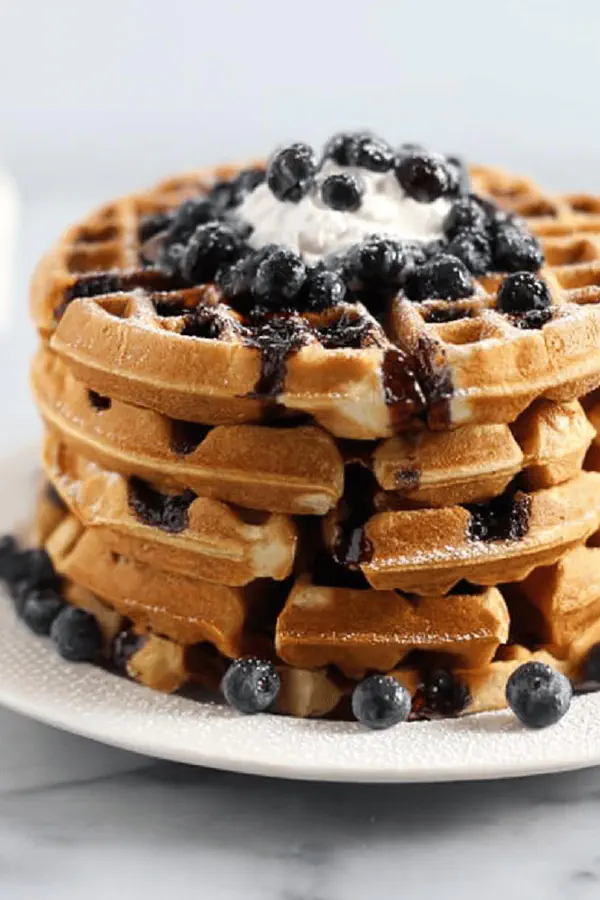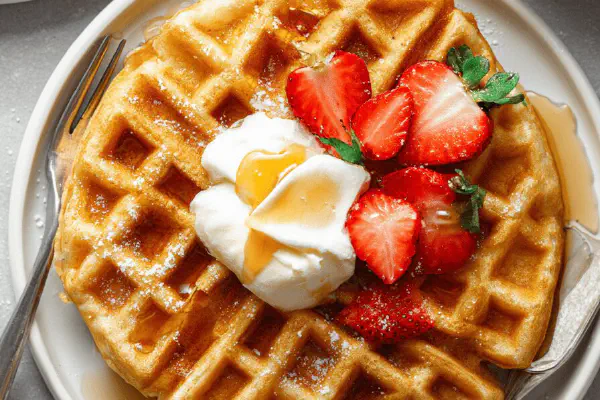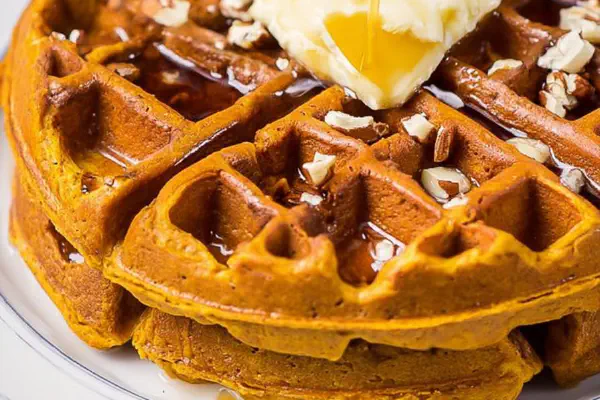Featured Recipe
Blueberry Butter Waffles

By Kate
"
Egg whites whipped to peaks, dry ingredients combined carefully, wet ingredients mixed just right. Folding in blueberries plus a twist of cinnamon and lemon zest for depth. Adjustments to sugar, flour quantities to balance texture. Melted ghee replaces butter for richer mouthfeel. Quick yet tactile waffle batter preparation. Waffles cooked till golden brown, crisp edges with fluffy interiors. Visual cues dominate timing. Serve topped with whipped cream, fresh berries, and a dust of powdered sugar. Substitutions for dairy or fruit included. Troubleshooting tips on batter consistency and waffles sticking to iron. Practical, sensory-driven, no guesswork kitchen method.
"
Prep:
12 min
Cook:
14 min
Total:
26 min
Serves:
4 servings
waffles
breakfast
brunch
dessert
Introduction
Eggs separated deliberately. Whipping whites takes patience but yields lightness you can see and feel. Avoid watery batter common mistake—overbeating eggs or overmixing flour do that. Adding lemon zest and cinnamon? That twist wakes up berries; complexity without extra sugar. Melted ghee chosen over butter for subtle nutty flavor and steady melting—helps wrinkles vanish from batter. Folding whites demands respect—fold too hard, air lost, waffles dense. Listen to steam slow, edges darken, smell nutty, caramelizing sugars. Waffles done. Not by timer but senses. Whip cream while waffles cook—peak just after soft peaks, no liquid sloshing. Fruity acid balances richness. Classic combo with practical tweaks from years behind stove. Some tips not in books—share crumbs here.
Ingredients
About the ingredients
Egg separation critical. Whites whipped in clean, grease-free bowl with a pinch of salt to stabilize foam. Use fresh eggs—older whites don’t whip as well. Measuring flour by weight preferred; if not, spoon flour lightly into cup and level with knife to avoid compacting. Cinnamon and lemon zest not mandatory but add dimension—you can swap in nutmeg or orange zest. Use ghee melted slowly to preserve texture; butter melts unevenly, sometimes burns flavor. Whole milk gives richness; evaporated milk can boost creaminess if you want extra density but reduce sugar slightly. Blueberries fresh hold shape better; if frozen, thaw and drain to avoid watery batter. Cooking spray oil should be neutral; olive oil imparts flavor but can smoke. Powdered sugar adds visual appeal but fine granulated sugar in batter ensures caramelization. Whipped cream stabilizes with touch of vanilla extract or a small pinch of sugar.
Method
Technique Tips
Whipping egg whites takes watching texture closer than time. Stop once stiff peaks form but glossy, not grainy. Over-whipped whites turn dry, lose volume when folded. Mixing wet to dry ingredients—do not try for uniform batter. Expect lumps. Folding whites must be gentle; scoop along side of bowl, lift batter over top, rotate bowl. Rushing here causes collapse. Fold blueberries last to prevent bursting. Preheat waffle iron fully before adding batter—it should sizzle lightly on contact but not burn. Cook until steam nearly stops escaping; smell caramelizing sugars, edges turn golden brown with slight crunch but center stays tender. Remove quickly to stop steaming inside crust. Serve immediately or keep warm on wire rack—stacking traps steam and loses crispness. Whipped cream should be thick enough to hold peaks but still soft; overbeaten cream turns grainy and melts quickly. If waffles stick, verify iron cleanliness and heat level. Adjust cooking times 1-2 minutes for thicker batter or higher altitude. If batter thickens too much after standing, sift in more milk. This recipe thrives on tactile and sensory cues more than rigid clocks.
Chef's Notes
- 💡 Egg separation is crucial. Clean bowls for whites. Pinch of salt stabilizes. Fresh eggs whip better. Look for soft peaks, stop before grainy. Be patient.
- 💡 Flour measuring? Weight preferred. If using cup, spoon flour lightly, level off. Avoid compacting it. Lumpy batter is okay; helps avoid too much gluten. Fold carefully.
- 💡 Cooking spray or oil—neutral flavor best. Avoid extra aromatic oils. Preheat iron until hot enough; can help create immediate crisp. Don't stack waffles or they'll steam.
- 💡 Adjust thickness; if runny add a bit more flour—just a sprinkle. Too thick? A splash of milk helps. Monitor steam and color as indicators; no need to rush.
- 💡 Whipped cream should hold soft peaks without overdoing it. A bit of vanilla stabilizes well. Grains in cream? You mixed too much. Careful with eggs; don’t rush folding.
Kitchen Wisdom
How to mix wet ingredients?
Beat yolks, vanilla, milk, ghee till mixed. Don’t overmix—temperature is key. Too hot ghee cooks yolks, messes texture.
What if waffles stick to the iron?
Check heat, oil. Not enough oil means sticking. Preheat properly or use clean iron. Always oil lightly.
Can I substitute blueberries?
Yes; raspberries or strawberries work. Make sure they're not too watery. Frozen? Thaw and drain before using.
What's the best way to store leftovers?
Keep in airtight container. Can last up to two days. Reheat in toaster oven or waffle iron. Best fresh though.



